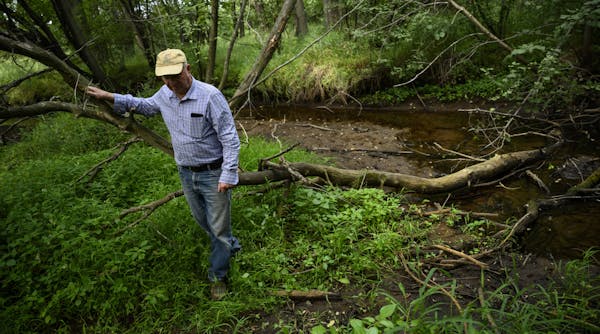An old dam on a troubled trout stream in central Minnesota has disrupted the water's flow for decades. Now the state will remove its gates to correct an error of the past and, perhaps, inch toward a resolution to a decade-old fight pitting the water needs of agricultural irrigation against fishing and aquatic life.
The Department of Natural Resources (DNR) built the small dam on Little Rock Creek in the 1970s to artificially prop up a pond the agency hoped would be used for duck hunting. It's one of hundreds of obsolete dams built over the past century for nearly forgotten reasons that are under scrutiny as the state and public look to restore the natural flow of waterways. The DNR hopes that opening the gates will cool the stream that often becomes too warm to keep trout and other fish alive.
"The water just gets warmed up there in the reservoir," said Randall Doneen, DNR conservation, assistance and regulation section manager. "It won't make much of a difference overall to the stream flow, but hopefully the water coming out of the reservoir now will be colder."
Little Rock Creek's problems run much deeper than the dam.
The creek cuts through the booming cropland of Morrison and Benton counties. The same irrigation that transformed the sandy soil of the region into thousands of acres of lush and thriving potato, corn, soybean and alfalfa fields also has sucked life from the stream.
Irrigation has lowered the creek's water levels by up to 25% during dry summers, according to the DNR.
When that happens, species such as brown trout and johnny darters, which are an important forage fish for larger species, lose a large chunk of their habitat. Other fish and insects suffer as well.
For 20 years, the Minnesota Pollution Control Agency (MPCA) has listed Little Rock Creek as impaired for being polluted, lacking enough oxygen for fish and insects, and having excess nitrate from farm chemicals. More impairments, including too much bacteria, were noted in 2020.
There are about 240 high-capacity irrigation wells in the area, one of the higher concentrations in the state, pumping an estimated 4 billion gallons of groundwater a year. DNR officials believe that if nine or 10 of those high-capacity wells were moved, using pipes to draw water further from the creek, it could solve most of the stream's water-level issues.
The question would be who would pay for it.
"Even though a few people could fix the problem, they would be fixing it for everybody, and it doesn't seem fair for the cost to land on few," Doneen said.
Similar conflicts are playing out across Minnesota as the state struggles to balance ever-growing demands on groundwater with the needs of its rivers and streams. Little Rock Creek is not the biggest body of water to be threatened, but what happens there could shape solutions elsewhere.
Debate has been going on for years over how to address the creek. Farmers are frustrated because they say they need to be certain that they will be able to draw groundwater to build and invest in their operations. But since the DNR might modify their permits at any time to conserve water, they have to live with uncertainty.
The DNR now is seeking proposals from the irrigators themselves for solutions that would keep stream levels up.
One option would be to pump groundwater to augment Little Rock Creek. But DNR officials are not sure that would be legal. Another option is to try to increase the amount of water that can be stored on the land by restoring or creating wetlands.
In a concession to farmers, the DNR's goal is not to prevent drawdowns of the creek, but to limit them to more than 15% of normal flow during dry summers, rather than 25%.
The DNR will monitor how much the removal of the dam helps water temperatures over the next three years.
The agency will keep meeting with farmers about a path forward, Doneen said.
"It's taken many years to figure this out," he said. "We're prepared to give folks time to come up with proposals. As long we're making headway and there is a good faith effort, we'll give them the time they need. But if people aren't doing anything and our only ability is to amend permits, well, then that's where we'll look."

Want to share info with the Star Tribune? How to do it securely

'Safe recovery sites' would offer syringes, naloxone and more to people using drugs. The plan could be in peril.
New Minnesota GOP leaders seek peace with party's anti-establishment wing

Who is Republican Lisa Demuth, Minnesota's first House speaker of color?

